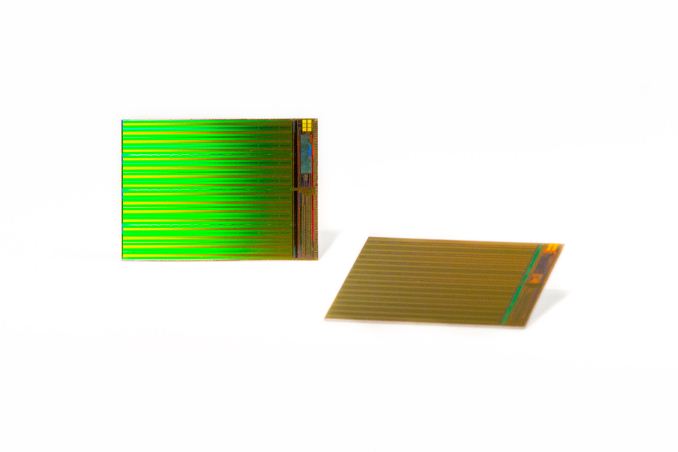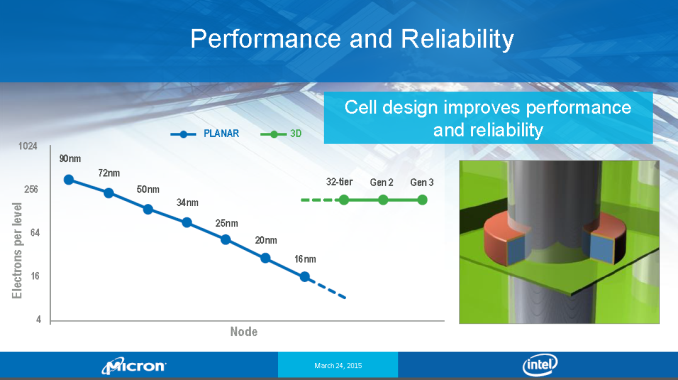Intel-Micron Share Additional Details of Their 3D NAND
by Kristian Vättö on March 26, 2015 2:20 PM EST
Today must be the busiest day in the world of NAND. Earlier today, Toshiba announced that it has begun sampling of its 48-layer 128Gbit 3D NAND part and now a few hours later Intel and Micron held a joint webinar that revealed a few new details about the companies' 3D NAND process. Intel-Micron originally unveiled their 3D NAND in November last year and disclosed that the first generation product will be a 32-layer 256Gbit (32GB) MLC part, which can also operate in TLC mode to bring the capacity per die to 384Gbit (48GB).
The initial part will be a 4-plane design, which is necessary for retaining high performance at such a high die capacity. For understanding why the number of planes is important, I suggest you read this page from our Crucial M550 review, but in short the number of planes translates to the number of pages that can be programmed in tandem within a single die (i.e. one page can be programmed in one plane at a time, so that's four simultaneous page programs in a 4-plane die). There's some additional latency from multi-plane programming, but with a 4-plane design you can get roughly two times the write (and read/erase too) throughput compared to a 2-plane design. That's a vital element because as the die capacity increases, less die is required to build a drive with fixed capacity (e.g. with 256Gbit die, a 256GB SSD only consists of eight dies, whereas with a 128Gbit die there would be 16 dies operating in parallel).
As I thoroughly explained in our Samsung 850 Pro review, one of the key issues with planar NAND is the shrinking number of electrons. Because 3D NAND can utilize a much larger cell structure due to the fact that scaling is done vertically rather than horizontally, the number of electrons is considerably higher, which improves both endurance and performance. The slide Intel and Micron shared shows that their 3D NAND will have roughly the same number of electrons as their 50nm process did (or actually slightly more), which is over a tenfold improvement compared to the latest 16nm node. The companies weren't willing to share the exact lithography that's used for manufacturing, but I was told that the process relies on single patterning and thus I would estimate the lithography to be somewhere between 35nm and 50nm given the limits of argon fluoride patterning. Ultimately the lithography on its own is rather useless anyway because it only measures the smallest pitch in the die and there's more than a couple of pitches that need to be known for any accurate analysis.
In terms of endurance, Micron told me that the parts will initially be rated at 3,000 P/E cycles. That may sound low, but Micron explained that the reason behind this is that all Micron's client-grade MLC has been rated at 3,000 for several years now and frankly that's more than enough for client applications. Both companies are confident that their 3D NAND technology is capable of delivering far more than that, but as validation takes time and money the first batch won't be rated at more than 3,000 cycles. It will be interesting to see what the enterprise-focused 3D NAND is rated at once it arrives to the market, but given the increased number of electrons and other endurance improvements it's safe to assume that Intel-Micron's 3D NAND will be capable of +10,000 P/E cycles as the process matures.
The companies also shared some high-level details of their 3D NAND structure, which has remained a secret until now. To be honest, the above illustration I was given is far from easy to understand (even the Intel/Micron engineers I talked had trouble understanding it), but what I was able to understand is that the purple tubes are the channels and the individual cells are between the channels and the green wordline (i.e. the actual cells are not really shown in the picture). Obviously, the graphs leave many questions unanswered (like how a single cell is accessed and where and how the wordlines are connected), so we'll have to wait for further details before we can fully understand how the structure differs from Samsung's and Toshiba-SanDisk's.
That said, Intel-Micron did disclose that their design utilizes a traditional floating gate, whereas the other 3D NAND designs we have seen use a newer charge trap technology. There's inherently several benefits to charge trap (e.g. less electron leakage), but Intel and Micron told me that they decided to use floating gate because it's a decades old design and the physics are well known, while charge trap is much newer and more unproven. It's impossible to outright say that one cell structure is better than the other because in the end it all boils down to cost where floating gate design is probably more cost efficient for Intel-Micron given their deep knowledge of its functionality.
All in all, we now know a few more bits about Intel-Micron's 3D NAND, but there's still lots of details to be unveiled and investigated to fully understand the differences to other 3D NAND technologies. 256Gbit MLC samples are now shipping to select customers and mass production will begin in the second half of this year, so the first products with Intel-Micron 3D NAND will likely hit the shelves in the first half of 2016.












34 Comments
View All Comments
rpg1966 - Friday, March 27, 2015 - link
Yes. It's blue and black.Kristian Vättö - Friday, March 27, 2015 - link
The description was based on a graph that was deleted by Micron's request and replaced by the graph that's now in place. Ryan deleted the graph while I was asleep, but didn't edit the explanation, hence the confusion. I've now edited the paragraph to be inline with the new graph.P.S. My color vision should be just fine, or at least I've never been diagnosed with color blindness :)
rpg1966 - Friday, March 27, 2015 - link
Given that they share at least one broadly similar feature size, does anyone know how Intel can cram 256Gbit (32GB) on 32 layers of MLC, whereas Samsung "only" manages 16GB over 48 layers?Kristian Vättö - Friday, March 27, 2015 - link
Larger die size and higher memory array efficiency due to the higher die capacity. Also, Samsung's 128Gbit (16GB) V-NAND is also 32-layer.